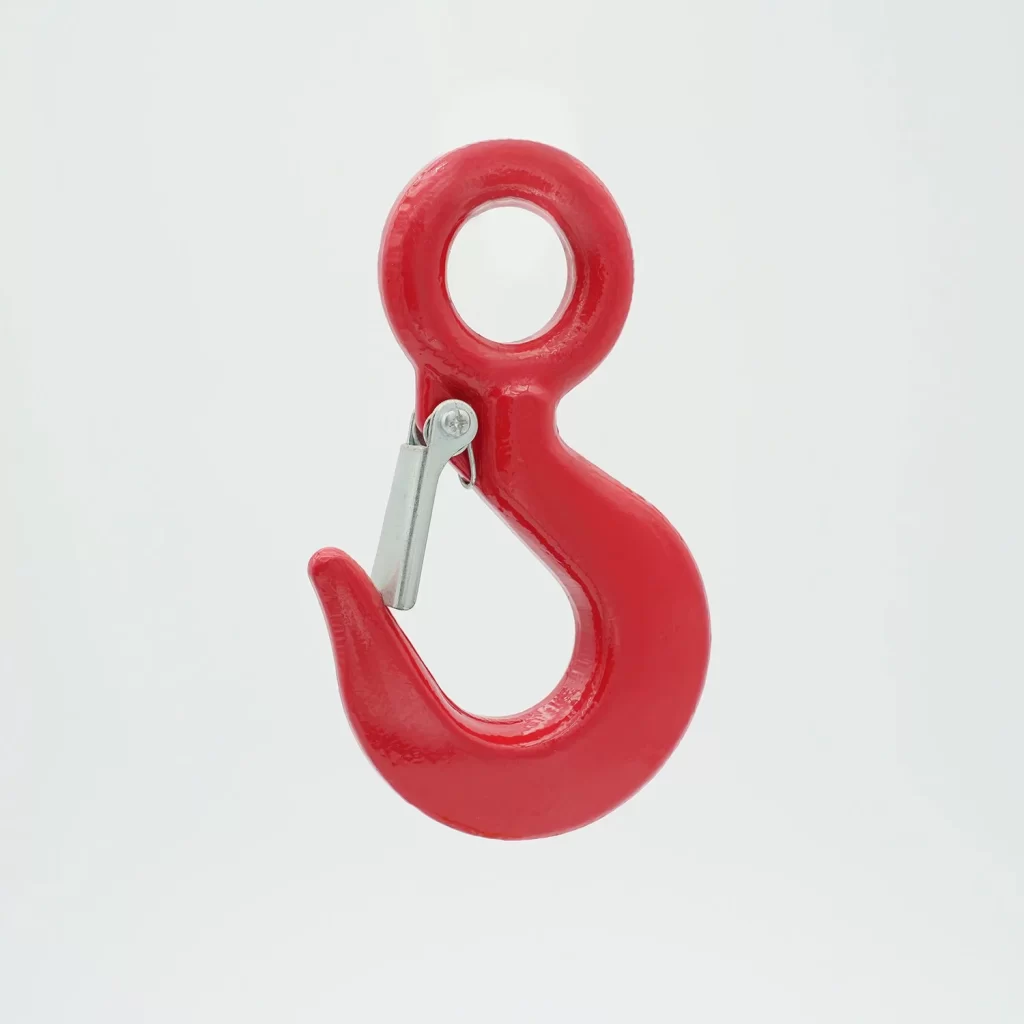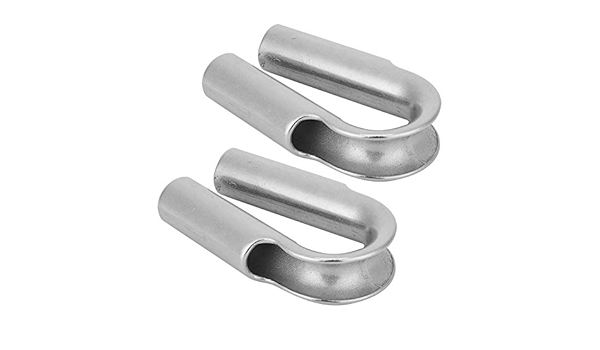When it comes to winching, using the right hardware is key to safety and performance. Two essential components are the winch hook and the thimble — each designed for specific functions. Winch hooks are built for quick, dynamic connections, while thimbles protect the rope during static, high-tension pulls. This guide breaks down the core differences to help you choose the right tool for your recovery setup.
What is the Difference Between a Winch Hook and a Thimble?
A winch hook is used for dynamic load handling and offers quick attachment in towing and recovery operations. A thimble, on the other hand, is designed for static load protection, ensuring the wire rope eye maintains its shape and integrity during continuous high-stress scenarios. Use a winch hook for fast connections and a thimble to protect the rope in scenarios requiring sustained tension in closed-system winching.
What is a Winch Hook?

A winch hook is a robust hook used to connect a load to a winch, enabling the lifting or pulling of heavy objects.
These hooks are designed for quick attachment and closed-loop systems, making them ideal for recovery operations, towing, and off-road winching.
What is a Thimble?

Thimbles, also called winch rope thimbles, protect the rope eye and ensure even load distribution in static operations, forming a closed-system setup.
Thimbles help maintain the integrity of the wire rope by providing a durable surface for the rope to loop around.
Types of Thimbles
- Open Thimbles: Easy to install and commonly used in lighter applications.
- Closed Thimbles: Provide extra security as the rope cannot slip out.
- Pressed Thimbles: Manufactured by pressing, offering high strength and durability.
Key Features
- Materials: Made from various materials like galvanized steel, stainless steel, and brass, each suited to different environments.
- Strength: Designed to enhance the durability of the wire rope.
- Compatibility: Available in various sizes to fit different wire ropes.
Applications and Industries
Marine, construction, and transportation industries frequently use thimbles for wire rope applications.
They are crucial in extending the lifespan of wire ropes by reducing wear and tear.
Winch Hook vs Thimble: Key Differences
Function and Purpose
Winch Hook: A winch hook is primarily used to connect and secure loads. It attaches to the load, allowing for lifting or pulling.
Thimble: A thimble is used to protect wire ropes. It maintains the shape of the rope and prevents it from being crushed or damaged at the eye.
Load-Bearing Capacity
Winch hooks are designed to directly bear the load they are lifting or pulling. They are built to handle heavy weights and stress.
Thimbles, on the other hand, support the load indirectly. They don’t bear the load themselves but protect the wire rope that does, helping to distribute the load more evenly and prevent damage.
Safety Considerations
Winch hooks often come with features like safety latches, swivels, and are compatible with soft shackles to enhance safety during dynamic winching operations. These latches prevent the load from slipping off the hook, and swivels allow the hook to rotate, reducing rope twists and kinks.
Thimbles focus on protecting the wire rope, which extends its life and reduces the risk of rope failure. They are crucial in ensuring the wire rope remains in good condition, especially in high-stress environments.
- Winch Hook: Best for dynamic load applications where quick attachment is required.
- Thimble: Ideal for static load scenarios requiring long-term wire rope protection and closed-loop systems.
Installation and Usage
Winch Hook: Installing a winch hook typically involves hooking it onto the load and securing the latch if there is one. It’s straightforward and quick to attach and detach.
Thimble: Installing a thimble requires placing it within the eye of the wire rope. This often involves proper crimping or splicing to ensure it stays in place and provides the necessary protection.
Maintenance and Inspection Requirements
Both winch hooks and thimbles require regular inspection to ensure they are in good working condition.
Winch Hook: Regularly check for deformation, cracks, or any signs of damage. Ensure that the latch and swivel mechanisms are functioning correctly.
Thimble: Inspect for signs of wear, corrosion, or deformation. Ensure that the thimble is still providing adequate protection to the wire rope and hasn’t become dislodged or damaged.
When to Use a Winch Hook
Scenarios Where Winch Hooks Are the Preferred Choice
Winch hooks are indispensable in situations where securing a load quickly and safely is paramount. Here are some common scenarios:
- Towing: When you need to tow a vehicle, a winch hook can be quickly attached to a tow point, making it ideal for roadside assistance or recovery operations.
- Recovery Operations: In off-roading or rescue missions, winch hooks allow for rapid connection to stranded vehicles or equipment.
- Heavy Lifting: Construction sites and industrial settings often require lifting heavy materials, and winch hooks provide a reliable connection point for cranes and hoists.
Advantages of Using Winch Hooks
- Ease of Attachment: Winch hooks are designed for simplicity. Attaching and detaching them is quick and straightforward, which is crucial in time-sensitive situations.
- Load Control: The safety features of winch hooks, such as latches and swivels, ensure secure load handling. Latches prevent accidental disengagement, while swivels allow the hook to rotate, reducing the chance of the rope or chain twisting.
Compatibility with Different Lifting Equipment and Setups
Winch hooks are highly versatile and can be used with various lifting equipment:
- Winches: The primary equipment for which winch hooks are designed. They enable the winch to pull or lift loads efficiently.
- Cranes: Winch hooks can be attached to crane cables, providing a secure point for lifting heavy objects.
- Pulleys: In pulley systems, winch hooks facilitate the connection between the rope and the load, ensuring smooth operation.
When to Use a Thimble
Thimbles are best suited for protecting wire ropes under continuous stress. Here are some typical scenarios:
- Marine Environments: In boating or maritime applications, wire ropes are exposed to harsh conditions. Thimbles help protect the ropes from wear and corrosion.
- Permanent Lifting Setups: In situations where wire ropes are used for long-term installations, such as in construction cranes or suspension bridges, thimbles maintain the integrity of the ropes over time.
Advantages of Using Thimbles
- Increased Wire Rope Lifespan: By reducing friction and wear, thimbles significantly extend the life of wire ropes. The smooth, curved surface of the thimble ensures that the rope does not bend or kink sharply, which can weaken it.
- Reduced Wear and Tear: Thimbles provide a durable surface for the rope to loop around, protecting it from damage caused by sharp bends or abrasive surfaces.
Compatibility with Different Wire Rope Sizes and Types
Thimbles come in various sizes and materials to suit different applications:
- Sizes: Thimbles are available in sizes that match specific wire rope diameters, ensuring a proper fit and optimal protection.
- Materials: Depending on the environment, thimbles can be made from galvanized steel, stainless steel, or other materials. Stainless steel thimbles, for instance, are ideal for marine applications due to their corrosion resistance.
Choosing the Right Component
Application Requirements: The first step in choosing between a winch hook and a thimble is understanding the specific needs of your operation. Consider what you will be lifting or pulling, the conditions under which you will be working, and the frequency of use.
For instance, if you need a quick-release mechanism for frequent load changes, a winch hook might be more suitable. Conversely, if you need to protect wire ropes in a static, high-stress environment, a thimble would be the better choice.
Load Specifications: It is crucial to ensure that the component you select can handle the load it will bear. Each winch hook and thimble has a maximum load rating, and exceeding this can lead to equipment failure and safety hazards.
Check the load-bearing capacity of the component and compare it with the maximum load you expect to handle. Remember to factor in safety margins as specified by industry standards to ensure reliable performance.
Environmental Conditions: The environment in which you will use the equipment also plays a significant role in your choice. For example, in marine environments where corrosion is a concern, stainless steel thimbles are ideal due to their resistance to rust.
In contrast, for general construction purposes where the risk of corrosion is lower, galvanized steel components might suffice. Evaluate the environmental conditions such as temperature, humidity, exposure to chemicals, and physical wear to choose a material that can withstand these factors.
Evaluating the Specific Application and Requirements
To make an informed decision, you need to thoroughly evaluate the specific application and requirements of your task. This involves a detailed assessment of :
Nature of the Load: Determine whether the load is static or dynamic. Dynamic loads, which involve frequent movement, may benefit from the flexibility and ease of attachment provided by winch hooks.
Static loads, where the wire rope remains in a fixed position, might require the durability and protection offered by thimbles.
Frequency of Use: Consider how often the component will be used. High-frequency operations may demand robust and easily operable components like winch hooks with safety latches and swivels.
For applications with infrequent load changes but continuous stress, thimbles that protect the wire rope may be more appropriate.
Installation and Maintenance: Think about the ease of installation and the maintenance requirements. Winch hooks are generally easier to install and replace, which is beneficial for tasks requiring quick setup and takedown.
Thimbles, while offering excellent protection, may require more meticulous installation to ensure proper wire rope protection.
Consulting with Experts or Professionals for Guidance
If uncertain about the best component, consult professionals for valuable insights..
These individuals have the experience and knowledge to help you understand the nuances of different applications and the best practices for safety and efficiency. They can assist in:
Assessing Your Specific Needs: Professionals can conduct a thorough assessment of your operation and help identify the most critical factors to consider.
They can offer tailored advice based on their understanding of your industry and specific use case.
Recommending Products: Based on their expertise, they can recommend specific products that have a proven track record of performance and reliability.
They may also suggest additional components or accessories that can enhance the safety and efficiency of your setup.
Providing Training and Support: Experts can offer training on the proper use and maintenance of the components, ensuring that your team is equipped with the knowledge to operate safely.
They can also provide ongoing support for troubleshooting and addressing any issues that arise.
Safety Considerations
Importance of Following Manufacturer’s Instructions and Guidelines
Adhering to the guidelines ensures the components are used correctly and safely, preventing accidents.
Proper Inspection and Maintenance Practices
Regularly inspect winch hooks and thimbles for signs of wear, deformation, or damage, and replace them as necessary to maintain safety.
Load Rating and Weight Limitations
Always respect the load ratings provided by the manufacturer to prevent overloading and potential failures.
Relevant Industry Standards and Regulations
Compliance with industry standards and regulations ensures that the components meet safety and performance criteria, protecting both equipment and personnel.
Conclusion
Winch hooks and thimbles are vital components in heavy lifting and pulling operations.
Understanding their differences, applications, and safety considerations helps in making informed decisions, ensuring the longevity of your equipment and the safety of your operations.
By choosing the right component whether for dynamic winching with hooks or static load protection with thimbles and following closed-system winching practices, you can ensure safe, efficient, and long-lasting winching operations.

